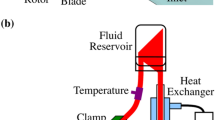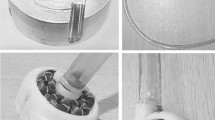Abstract
Purpose
Rotary blood pumps (RBPs) employed as ventricular assist devices are developed to support the ventricles of patients suffering from heart failure. Computational Fluid Dynamics (CFD) is frequently used to predict the performance and haemocompatibility of these pumps during development, however different simulation techniques employed by various research groups result in inconsistent predictions. This inconsistency is further compounded by the lack of standardised model validation, thus it is difficult to determine which simulation techniques are accurate. To address these problems, the US Food and Drug Administration (FDA) proposed a simplified centrifugal RBP benchmark model. The aim of this paper was to determine simulation settings capable of producing accurate predictions using the published FDA results for validation.
Methods
This paper considers several studies to investigate the impact of simulation options on the prediction of pressure and flow velocities. These included evaluation of the mesh density and interface position through steady simulations as well as time step size and turbulence models (k-ε realizable, k-ω SST, k-ω SST Intermittency, RSM ω-based, SAS and SBES) using a sliding mesh approach.
Results
The most accurate steady simulation using the k-ω turbulence model predicted the pressure to within 5% of experimental results, however experienced issues with unphysical velocity fields. A more computationally expensive transient simulation that used the Stress-Blended Eddy Simulation (SBES) turbulence model provided a more accurate prediction of the velocity field and pressure rise to within experimental variation.
Conclusion
The findings of the study strongly suggest that SBES can be used to better predict RBP performance in the early development phase.








Similar content being viewed by others
References
ANSYS Inc. ANSYS Fluent theory guide 15.0. Canonsburg, PA, 2013.
ANSYS Inc. ANSYS Fluent User’s Guide 15.0. Canonsberg, PA, 2013.
ANSYS Inc. ANSYS fluent theory guide 17.0. Canonsburg, PA, 2016.
Behbahani, M., M. Behr, M. Hormes, U. Steinseifer, D. Arora, O. Coronado, et al. A review of computational fluid dynamics analysis of blood pumps. Eur. J. Appl. Math. 20:363–397, 2009. https://doi.org/10.1017/S0956792509007839.
Burgreen, G. W., J. F. Antaki, Z. J. Wu, and A. J. Holmes. Computational fluid dynamics as a development tool for rotary blood pumps. Artif. Organs 25(5):336–340, 2001. https://doi.org/10.1046/j.1525-1594.2001.025005336.x.
Fraser, K. H., M. E. Taskin, B. P. Griffith, and Z. J. Wu. The use of computational fluid dynamics in the development of ventricular assist devices. Med. Eng. Phys. 33:263–280, 2011.
Gross-Hardt, S. H., S. J. Sonntag, F. Boehning, U. Steinseifer, T. Schmitz-Rode, and T. A. S. Kaufmann. Crucial aspects for using computational fluid dynamics as a predictive evaluation tool for blood pumps. ASAIO J. 65(8):864–873, 2019. https://doi.org/10.1097/MAT.0000000000001023.
Heck, M. L., A. Yen, T. A. Snyder, E. A. O’Rear, and D. V. Papavassiliou. Flow-field simulations and hemolysis estimates for the food and drug administration critical path initiative centrifugal blood pump. Artif. Organs 41(10):11, 2017.
Ji, J. J., X. W. Luo, and Q. Y. Wu. Design optimization of flow channel and performance analysis for a new-type centrifugal blood pump. IOP Conf. Ser. 52(2):022012, 2013.
Malinauskas, R. A., P. Hariharan, S. W. Day, L. H. Herbertson, M. Buesen, U. Steinseifer, et al. FDA benchmark medical device flow models for CFD validation. ASAIO J. 63(2):150–160, 2017.
Marinova, V., I. Kerroumi, A. Lintermann, J. H. Göbbert, C. Moulinec, S. Rible, et al. Numerical analysis of the FDA centrifugal blood pump. NIC Symposium 2016. Jülich, Germany: Forschungszentrum Jülich GmbH, Zentralbibliothek, 2016.
Menter, F. (ed.). Stress-blended eddy simulation (SBES)—a new paradigm in hybrid RANS-LES modeling. Symposium on Hybrid RANS-LES Methods. Springer, 2016.
Nassau, C. J., T. J. Wray, R. K. Agarwal, eds. Computational fluid dynamic analysis of a blood pump: an FDA critical path initiative. ASME/JSME/KSME 2015 Joint Fluids Engineering Conference. American Society of Mechanical Engineers, 2015.
Oberkampf, W. L., T. G. Trucano, and C. Hirsch. Verification, Validation, and Predictive Capability in Computational Engineering and Physics. United States: US Department of Energy (US)2003 Contract No.: Report.
Shah, S. R., S. V. Jain, R. N. Patel, and V. J. Lakhera. CFD for centrifugal pumps: a review of the state-of-the-art. Procedia Eng. 51:715–720, 2013. https://doi.org/10.1016/j.proeng.2013.01.102.
Stewart, S. F. C., E. G. Paterson, G. W. Burgreen, P. Hariharan, M. Giarra, V. Reddy, et al. Assessment of CFD performance in simulations of an idealized medical device: results of FDA’s First Computational Interlaboratory Study. Cardiovasc. Eng. Technol. 3(2):139–160, 2012. https://doi.org/10.1007/s13239-012-0087-5.
Taskin, M. E., K. H. Fraser, T. Zhang, B. Gellman, A. Fleischli, K. A. Dasse, et al. Computational characterization of flow and hemolytic performance of the ultramag blood pump for circulatory support. Artif. Organs 34(12):1099–1113, 2010. https://doi.org/10.1111/j.1525-1594.2010.01017.x.
US Food and Drug Administration. Computational Fluid Dynamics: An FDA Critical Path Initiative, 2017. https://fdacfd.nci.nih.gov/.
Wiegmann, L., S. Boës, D. de Zélicourt, B. Thamsen, M. S. Daners, M. Meboldt, et al. Blood pump design variations and their influence on hydraulic performance and indicators of hemocompatibility. Ann. Biomed. Eng. 46(3):417–428, 2018.
Woelke, M. Eddy viscosity turbulence models emploed by computational fluid dynamic. Prace Instytutu Lotnictwa 4:92–113, 2007.
Yu, H., S. Engel, G. Janiga, and D. Thévenin. A review of hemolysis prediction models for computational fluid dynamics. Artif. Organs 41:603, 2017.
Acknowledgments
The authors would like to acknowledge the financial support provided by the Australian Postgraduate Awards and The Prince Charles Hospital Foundation (NI2017-15). We acknowledge the support of the Griffith University eResearch Services Team and the use of the High Performance Computing Cluster "Gowonda" to complete this research. Shaun D Gregory was supported by a Fellowship (102062) from the National Heart Foundation of Australia.
Funding
Clayton Semenzin received a grant provided by The Prince Charles Hospital Foundation (NI2017-15). Shaun D Gregory was supported by a Fellowship (102062) from the National Heart Foundation of Australia.
Conflict of interest
The authors declare no conflict of interest.
Author information
Authors and Affiliations
Corresponding author
Additional information
Associate Editor Amy L. Throckmorton oversaw the review of this article.
Publisher's Note
Springer Nature remains neutral with regard to jurisdictional claims in published maps and institutional affiliations.
Rights and permissions
About this article
Cite this article
Semenzin, C.S., Simpson, B., Gregory, S.D. et al. Validated Guidelines for Simulating Centrifugal Blood Pumps. Cardiovasc Eng Tech 12, 273–285 (2021). https://doi.org/10.1007/s13239-021-00531-0
Received:
Accepted:
Published:
Issue Date:
DOI: https://doi.org/10.1007/s13239-021-00531-0




